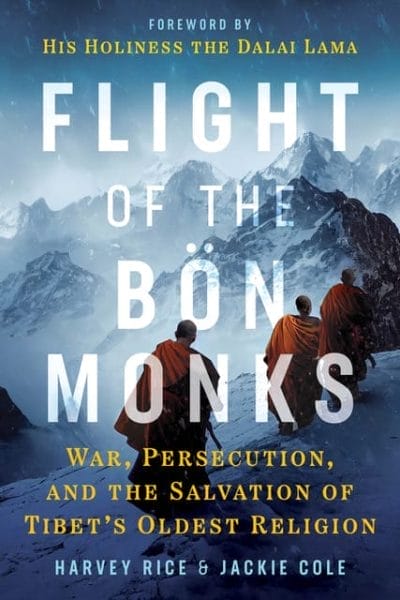This excerpt from “Flight of the Bon Monks” describes the arrival of the most important official in the Bön religion at a remote monastery after escaping an ambush by the Chinese military. Tenzin Namdak greets the abbot of Menri Monastery and begins planning an escape from Tibet.
Book Spotlight – The Flight of the Bön Monks
Written by Harvey Rice and Jackie Cole

Tenzin received disturbing news at Sezhig with the arrival of a jangling caravan of mules and horses laden with goods accompanied by an armed escort. It was late 1959, the Year of the Earth Pig.
The rare arrival of a trading party on the vast, empty plateau was always a pleasant break in the routine of life on the Changthang. The wealthy trader who led the party asked to pay his respects to Tenzin. The trader had been doing business on the Changthang when he received news of the failed Lhasa rebellion, the scale of the killing, and the destruction of the city. Upon learning that the Dalai Lama had fled the country, the merchant decided to follow the Dalai Lama’s example. He couldn’t leave, however, knowing that a lama of great repute was nearby and would certainly be a target of Chinese retribution. Even though they had never met, the trader felt it was his religious duty to assist Tenzin.
The trader described the carnage in Lhasa and what he knew of the Dalai Lama’s escape. He urged Tenzin to flee with him to Nepal. He and his retinue were well-equipped with pack animals, supplies, and weapons and could make Tenzin’s escape as comfortable and safe as possible for such a journey. But Tenzin could not leave without first knowing whether the abbot of Menri and his friends at the monastery were safe. An emissary from Menri was due to arrive at Sezhig to collect the mother monastery’s share of donations, which had increased substantially since Tenzin’s arrival. The trader waited for several days but finally told Tenzin he could wait no longer. Each day, the danger of capture increased.
Tenzin waited as 1959 faded and turned into 1960, the Year of the Iron Rat. When the emissary from Menri finally arrived, he confirmed the news about the Lhasa revolt, the Dalai Lama’s escape, and the flight of many Tibetans from their country but said nothing to suggest that Chinese pressure on Menri had worsened. Tenzin listened with concern. He was worried about his friends and students at Menri. He was worried about his country.
Tenzin was alternately alarmed and overjoyed several weeks later when Menri abbot Sherab Lodrö and a group of disheveled monks stumbled into Sezhig. Two were nursing wounds from Chinese bullets, and all wore tattered, dirty clothing. Tenzin listened with dismay as they told him about their clashes with the Chinese and their struggle to survive. Only fifteen of the thirty-six who set out from Menri made it to Sezhig; they would never learn the fate of the missing. Tenpa Woser was barely able to walk by the time he reached Sezhig. He staggered into the monastery and collapsed. Within minutes of his arrival he was carried to a bed and placed in the care of Shanghee, the only monk at Sezhig with any training in Tibetan medicine.
Shanghee immediately prepared to remove the bullet. Monks surrounded the bed and chanted, some sprinkling blessing water and others wafting smoke over him from the smoldering bunches of herbs they held in their hands. Shanghee had no anesthetizing herbs to offer, not even alcohol. He cleaned the wound and began cutting with a small knife as Tenpa passed in and out of consciousness from the pain. The bullet was removed, and the infection was cut away. The monks bandaged the wound as best they could with strips of torn cloth. Tenpa still bled. He sipped a bit of his own blood with a cupped hand, following the Tibetan belief in the restorative powers of blood. It seemed to ease his pain somewhat. He lay there for days, barely able to move, as the wound slowly healed.
While Tenpa was recovering, Tenzin Namdak began making plans for their escape to Nepal. He listened with sorrow as the abbot of Menri, Sherab Lodrö, told him about their deadly encounters with the Chinese and the missing monks, either captured, killed, or in hiding. He was disturbed to learn that their most sacred relic, the Nyame Kundung, had been hauled into a battle. Machen, one of the young monks to whom the relic had been entrusted, had to fight the Chinese with the relic lashed to his horse. He nearly lost it when his horse was shot. To ensure that the sacred Nyame Kundung would not be lost should they be confronted again by Chinese troops, Tenzin took it into his care, along with several solid gold butter lamps and other sacred objects carried by the Menri monks.
Refugee monks from Menri and other Bön monasteries straggled into Sezhig with similar stories of flight from Chinese pursuers. The most important figures in the Bön religion were now assembled at Sezhig, but the arrival of Tenpa and the refugees from Menri also meant that the Chinese were likely not far behind.
“Let us leave as soon as possible,” Tenzin urged. Preparations began immediately, and monks at Sezhig were given the same option as those at Menri: leave or await the Chinese. Amid the preparations for departure, a group of armed Tibetan resistance fighters arrived. They were led by a powerful tribal leader in the region, Nagtshang Powo, who had taken up arms against the Chinese. Nagtshang Powo bragged to Tenzin that the Americans were going to supply him with weapons that would enable him to protect the monks as well as arm those who had renounced their vows. He asked Tenzin to wait two weeks for the shipment to be air-dropped. As a sign of goodwill, he made an offering of gold and food to the monastery.
The weapons that Nagtshang Powo promised were to be delivered by the U.S. Central Intelligence Agency. The CIA was making arms drops as part of a covert operation to supply and train Tibetan rebels.
The program would last until 1961 and remained secret until the late 1990s. The Cold War was at its height, and the administration of U.S. President Dwight Eisenhower viewed covert action as a means to challenge Communism while avoiding overt military action that could lead to war.
To learn more or to purchase YOUR copy, click the book cover above or visit Amazon.com!
Learn more about getting your book, product, or event featured in an OMTimes Spotlight!
 About the Authors
About the Authors
The authors, Harvey Rice and Jackie Cole, are a husband-and-wife team. Rice spent 18 years as a reporter for the Houston Chronicle. Cole has studied Bön for over two decades and has many contacts in the worldwide Bön community. The authors live in Galveston, Texas.
https://flightofthebonmonks.com/
OMTimes is the premier Spiritually Conscious Magazine. Follow Us On Facebook, Twitter, Instagram, Linkedin, Pinterest, and Youtube













